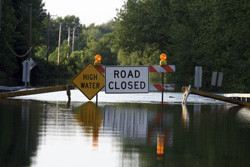High-tech solutions for flood protection
Flooding from rivers and coastal waters or as a result of intense rainfall can have a devastating impact on property and threaten life. Due to climate change, the extent and consequences of flooding are likely to become more severe in the future. It is, for this reason, essential not only to know the flood risk, but also to take measures in advance to protect people and their homes. The EU-funded 'Smart resilience technology, systems and tools' (SMARTEST)(opens in new window) project was initiated to promote the adoption of flood protection technologies and facilitate the design of holistic flood defence systems. During its three-year lifetime, it sought to open the route to market for innovation and support implementation of the European policy on flood risk management. SMARTEST brought together academics and researchers from different disciplines who analysed how conventional technologies for flood protection are deployed. After reviewing the best and worst practices in the adaptation or construction of buildings, they developed guidelines for employing flood protection systems. They also assessed obstacles in the uptake of new technologies and isolated opportunities to overcome them. The European market has seen the emergence of smart flood resilience technology. Such technology may be based on automatic control of barriers and protection walls, or innovative materials for higher performance. SMARTEST partners worked with manufacturers, consultants, the insurance industry, environmental agencies and local authorities to establish standards and test the new products. A wide range of innovative flood resilience products was tested in the laboratory. Based on the results, the team created a database with reliable information on the performance of each technology as well as its limitations. SMARTEST identified performance tests as one of the keys to supporting adoption of smart flood resilience technologies. However, further research is needed before integrating the new technologies into flood risk management plans. Project researchers have developed models to assess the extent of flooding and help decision makers be better informed of the potential impact. Linked to the decision-support platform(opens in new window) available on the project website, these can be used to determine the benefits of flood protection technologies. The SMARTEST project was innovative in the design of flood protection strategies. Together with the European policy 'Living with floods', these will support the implementation of portfolios of measures that contribute to strengthening flood resilience.



